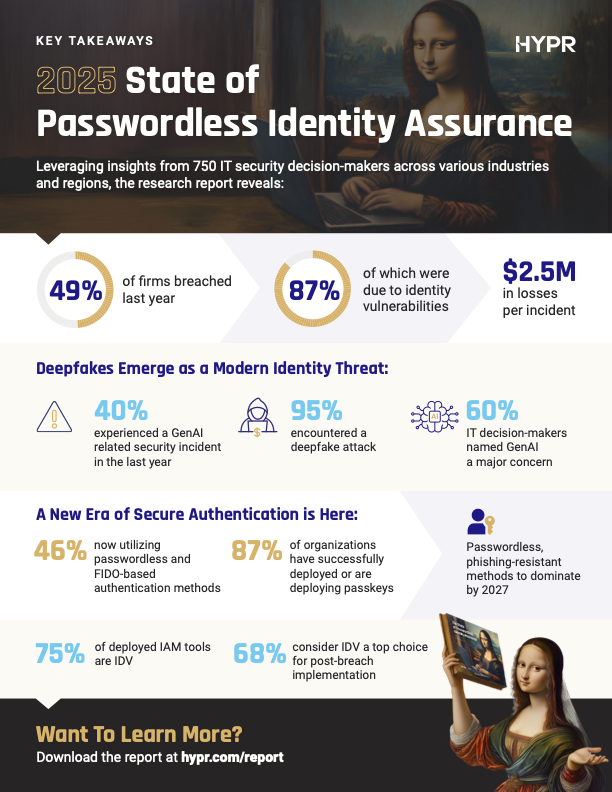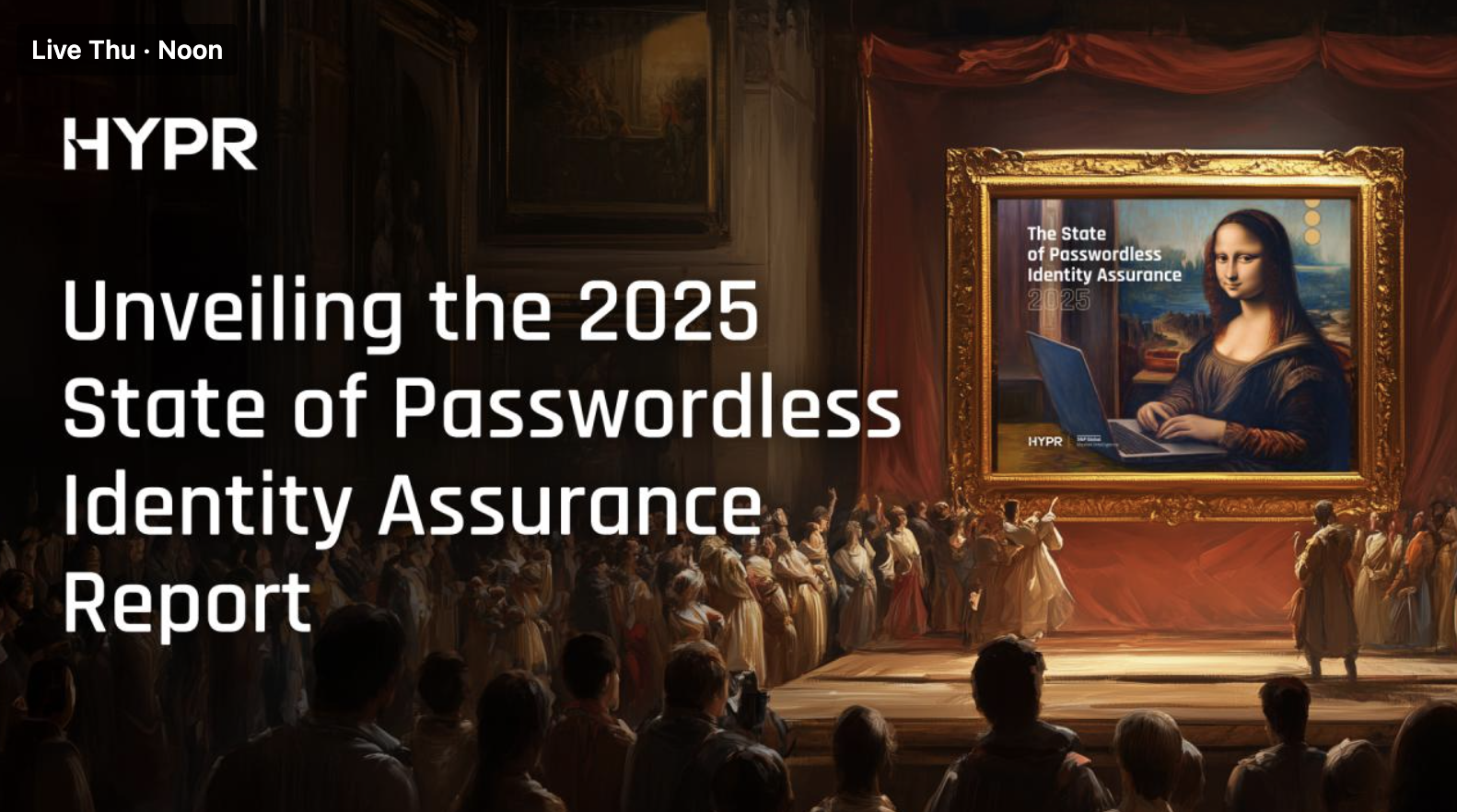Stay ahead of the curve with the latest news, ideas and resources on all things Identity Assurance and Passwordless.
Top Passwordless Identity Assurance Trends for 2025
Summary of Important Findings
- Nearly half (49%) of all firms were beached in the last year and the majority (87%) were attributed to identity vulnerabilities.
- Almost 40% of organizations experienced a security incident due to GenAI in the last 12 months alone.
- Phishing-resistant authentication methods are projected to be the most widely deployed authentication methods within the next two years.


“The Renaissance Man” was attributed to Leonardo da Vinci because he symbolized the focus of the Renaissance era: boundless human potential. The 2025 State of Passwordless Identity Assurance Report revolves around the Identity Renaissance: the exploration of business success when it’s unburdened by security vulnerabilities and inefficiencies. The report stresses the vitalization of shifting away from passwords and adopting comprehensive security infrastructure.
Recap still too long? Join me for a short report briefing, form-free registration here!
Where Does Identity Security Stand in 2025?
- Threat landscape
Organizations increasingly acknowledge that strong security is now positioned as a basic business need. Threat actors are linked by a common thread: the report findings suggest that online attackers are specifically targeting identity assets and infrastructure.
Nearly half of all respondents (49%) reported experiencing a breach in the last year, and an overwhelming majority (87%) of successful breaches were related to the exploitation of holes in identity processes. Credential misuse (47%), privileged access abuse (41%), social engineering (36%), and MFA bypass attacks (35%), account for the majority of breaches organizations experienced.
More and more, breaches are attempted with evolving audio and visual deepfake techniques. The unethical use of Generative AI has impacted 40% of responding organizations in the last year alone. The exponential growth of these tools creates significant security demand, especially for organizations that continue to use legacy authentication methods, like passwords and one-time-passcodes. This has solidified a need for phishing-resistant authentication methods, or methods that eliminate shared credentials and rely on cryptographic measures, like passkeys, to prevent phishing attacks. - Authentication methods
Currently, most organizations maintain identity security practices that lag behind the changing context of the digital world. Fortunately, this is attributed to a failure to adopt necessary security upgrades – not the inexistence of effective authentication methods. In other words, organizations can access everything they need to thrive – today.
The results of the report establish that traditional authentication methods are major security vulnerabilities. However, a startling 40% of respondents reported using these access methods. Nevertheless, 52% of respondents communicated that they use traditional MFA to authenticate, but this method still leaves enterprises vulnerable.
Despite the current statistics, for the first time in the five years the State of Passwordless Identity Assurance report has existed, the results suggest that the most widely deployed authentication methods will be phishing-resistant within the upcoming two years.
1. Digital threats strengthen daily.
2. The protective strategies most organizations have adopted are outdated.
The Identity Renaissance: The Shift to Passwordless in 2025 and Beyond
The Identity Renaissance was inspired by the broken relationship between current identity verification methods and the threats they seek to repel. It encapsulates the shift not only in the ways we approach identity verification, but also in the ways we perceive our digital identities. To embrace the Identity Renaissance, we are moving from authenticating accounts to verifying humans with advanced identity verification. Only assured identities should have the ability to access your resources and networks.
Fraud and exploitation are too pervasive to justify the use of knowledge-based factors. This creates an urgent need for organizations to abandon passwords, solidifying security and relieving burdens associated with password maintenance (including credential resets). The extinction of passwords comes as a reprieve for everyone in an organization, from CISOs, who must uphold a standard of perfection against breaches, to help desks, who struggle to address problems associated with shared credentials.
The future of identity security begins where passwords end. But eliminating passwords is only the first step – true security requires protecting every critical touchpoint in the identity lifecycle, from employee onboarding to credential and device resets. To achieve this, organizations must take a holistic approach that combines authentication with robust identity verification, ensuring that every access attempt is backed by trust. Only then can we secure identities from end to end and stop modern threats before they take hold.
Developing a successful business is difficult enough. The Identity Renaissance celebrates the idea that businesses shouldn’t expend energy preventing online attackers from inhibiting their progress. Ultimately, energy is better spent fueling achievement and growth.
Get the Full Picture: Download the State of Passwordless Identity Assurance Report
The Renaissance kickstarted our perception of the Earth. However, no single Renaissance discovery alone would have been enough. From Galileo's revelation and popularization of heliocentrism, to Magellan’s circumnavigation of the planet, to Amerigo Vespucci’s expeditions within it, it’s only through the combination of findings that we’re able to understand the world.
By exploring the 2025 State of Passwordless Identity Assurance Report, you’re accessing insights from hundreds of CISOs, IAM leads, and security architects.
How will the data included in the report benefit you? It will:
- Provide a clear understanding of the threats you’ll confront this year.
- Afford you the opportunity to benchmark your progress in comparison to other industry leaders.
- Supply you with actionable strategies you can use to bolster your defenses.
- Equip you with data you can pull from to justify budget requests.
It's a download away.
Don't forget to join us for a live briefing this Thursday!
Bojan Simic
CEO, HYPR
Bojan Simic is the Chief Executive Officer & Co-Founder of HYPR. Bojan's vision for the elimination of shared secrets and his experience in authentication & cryptography serves as the underlying foundation for HYPR technology and company strategy. Previously, he served as an information security consultant for Fortune 500 enterprises in the financial and insurance verticals conducting security architecture reviews, threat modeling, and penetration testing. Bojan has a passion for deploying applied cryptography implementations across security-critical software in both the public and private sectors. Bojan also serves as HYPR’s delegate to the FIDO Alliance board of directors, empowering the alliance’s mission to rid the world of passwords.
Related Content

